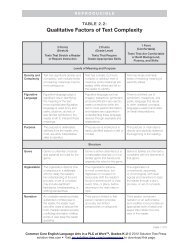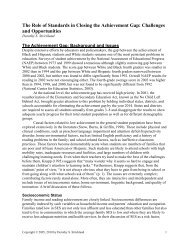Global Education Digest 2012 - International Reading Association
Global Education Digest 2012 - International Reading Association
Global Education Digest 2012 - International Reading Association
Create successful ePaper yourself
Turn your PDF publications into a flip-book with our unique Google optimized e-Paper software.
A N N E X<br />
A4<br />
DEFINITIONS<br />
Adjusted net intake rate (ANIR). Total enrolment in primary education of pupils of official primary school<br />
entrance age, expressed as a percentage of the population of the same age in a given school year. It is the<br />
equivalent of the age-specific enrolment rate of the official primary entrance age. It measures the actual level of<br />
access to primary education of the population of the official primary school entrance age.<br />
Adjusted primary net enrolment rate (ANER). Total number of pupils or students of official primary school<br />
age who are enrolled in primary or secondary education, expressed as a percentage of the corresponding<br />
population. It measures actual school participation of the official primary school age population and assesses the<br />
level of achievement of the universal primary education (UPE) goal.<br />
Capping. Indicators that surpass a theoretical maximum value are adjusted using a capping factor. The<br />
maximum value is determined using raw data from related indicators. Male, female and total values are<br />
recalculated and lowered by the capping factor so that the gender parity index of the new set of values<br />
remains the same as for the original values. For instance, net enrolment rates in primary education are capped<br />
using a factor that takes into account the male and female primary school-age populations and enrolment<br />
of primary school-age boys and girls in pre-primary, primary and secondary education. If the total enrolment<br />
of primary school-age children (whether male or female) is higher than the corresponding population, all net<br />
enrolment indicators (net enrolment rate, adjusted net enrolment rate, etc.) and their derivative indicators<br />
(out-of-school rate, etc.) are capped based on the same capping factor. In this case, the capping factor is<br />
calculated by taking the maximum of male and female enrolments and dividing by the primary school-age<br />
population of the same sex.<br />
Class. A class is made up of pupils or students who are following a common course of study. Pupils/students<br />
are grouped together in a class based on the highest number of common courses, usually compulsory studies.<br />
A class is the pedagogical structure in which each pupil/student is registered. Regardless of the level of study, a<br />
pupil/student is registered in only one class. Pupils/students from different grades may be present in the same<br />
class, as occurs in one-teacher or two-teacher schools. Conversely, a school may have a number of classes for<br />
the same grade.<br />
Class size. The number of enrolled students divided by the number of classes for the whole country. To ensure<br />
comparability among countries, special needs programmes are excluded. Data include only regular programmes<br />
at primary and lower secondary levels of education and exclude teaching in sub-groups outside the regular<br />
classroom setting.<br />
Compulsory education. The number of years or age span during which children are legally obliged to attend<br />
school.<br />
62

















